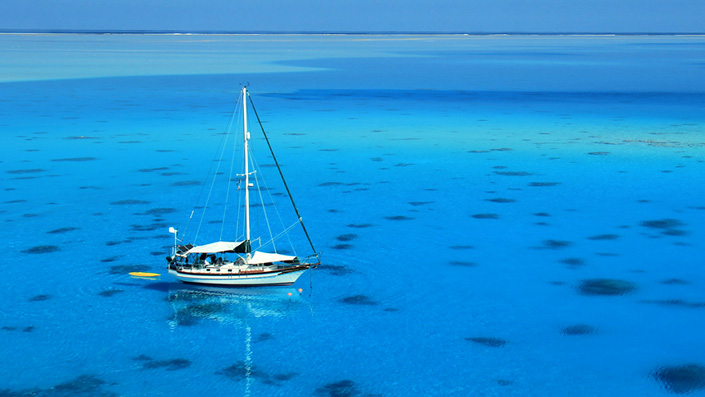
                                        
                                         

         
  


| |

| |
Dream Time anchored back in home waters flying all her courtesy flags after sailing a remarkable 50,252 nautical miles over fourteen years |
|
Thank You Dream Time
For fourteen years we explored the world under sail, living on a sailboat with a cabin space not much larger, and with considerably less headroom, than a generous walk-in closet. As our route map above shows we set sail from New York with a clear purpose to travel, without detour, around the world, our prediction - a five year circumnavigation, although we really had no specific schedule in mind. But in 2009 Dream Time entered the South Pacific and crossed the equator for the first time, where we discovered not only the most beautiful and romantic islands in the world, but our independence. For a total of eight years we happily explored the islands of Oceania, meandering from one impossibly idyllic archipelago to the next. We lived off-the-grid, wind and sun provided us with power, our desalinator provided us with fresh water, and the ocean our protein. One remote uninhabited anchorage was home for a total of 228 days. It was our most magical time.
But in the Spring of 2024 Dream Time welcomed a new owner, an American we first met in Belize over sixteen years ago at the very beginning of our world journey. A man who would become our friend and who would later help us transit Dream Time through the Panama Canal into the Pacific and sail with us in Tonga and Tahiti. It seems they were destined to be together. So while it may be the end of our magnificent voyage with Dream Time, she is in caring and familiar hands, and we are grateful for that. |
|

2024 | A New Journey: Sailing south to the Bahamas, Mana and Dream Time share an anchorage
But our adventures are not over, indeed they have begun anew! In 2024 we purchased a Fountaine Pajot Lucia, a forty-foot sailing catamaran that we have named Mana. We first heard of mana (maa-nuh) in the remote tropical islands of the South Pacific. It is a word rooted in Polynesian and Oceanic cultures by an intrepid people who, over two thousand years ago, without charts or any knowledge of what lay over the distant horizon, boldly sailed their double-hulled canoes from Southeast Asia across the world's largest ocean. They believe mana is an energy that permeates the universe and is a cultivation or possession of power. It is an intentional force that a person, place, and even an object, like a Fountaine Pajot catamaran, can possess.
Mana's adventures may one day share the pages of zeroXTE, but until then the website will remain a tribute to Dream Time - a proud little boat that took us on a grande adventure, and who always kept us safe. Thank you Dream Time!
To experience Dream Time's voyage please select a flag above to browse by region, enjoy published stories in our press area, or simply drift amongst the years and months of previous entries. We hope you enjoy the journey.
|

Have a question or comment? Contact Neville & Catherine >


|

Voyaging facts from Dream Time's logbook
 . .
Interested to learn some Dream Time voyaging statistics? Below are a few figures and averages collected and calculated from over four thousand log book entries:
| |
Total number of days: |
5,123 |
|
| |
Total distance travelled (nautical miles): |
50,252 |
|
| |
Countries visited: |
40 |
|
| |
Top wind speed whilst underway: |
45 knots (New Zealand to Austral Islands, 2011) |
|
| |
Average wind speed whilst underway: |
14.8 knots |
|
| |
Top wind speed whilst anchored: |
70 knots (Balearic Islands, 2019) |
|
| |
Average moving speed: |
4.8 knots |
|
| |
Fastest speed over ground: |
13.5 knots (Surfing down a 30 foot wave) |
|
| |
Average wave height: |
4.6 feet |
|
| |
Largest wave height: |
30 feet (New Zealand to Austral Islands, 2011) |
|
| |
Longest passage: |
28 days / 3,142 nautical miles (Galapagos to Marquesas, 2009) |
|
| |
Underway - percentage sailing vs motoring: |
72% pure sailing / 28% motoring or motor sailing |
|
| |
Total engine hours used in 14 years: |
5,103 (an average of 15 days a year) |
|
| |
Total percentage overnight passage making: |
6.8% |
|
| |
Longest anchorage (total combined days): |
228 days (Fakarava, Tuamotus 2011-2013) |
|
| |
Best sailing passage: |
Atlantic crossing (3,579 nautical miles, 100% sailing, 2020) |
|
| |
Fastest passage: |
7 knot average (841 nautical miles, New Caledonia to Australia, 2016) |
|
| |
Most significant gear failure: |
Forestay (New Zealand to Austral Islands, 2011) |
|
| |
Gear that required the most servicing: |
The head (Skipper Head II) |
|
|
|







